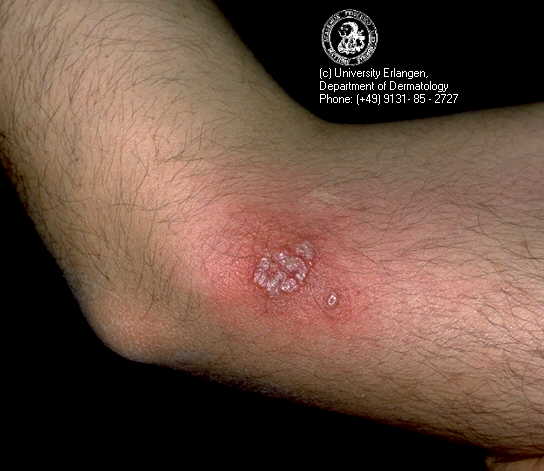
|
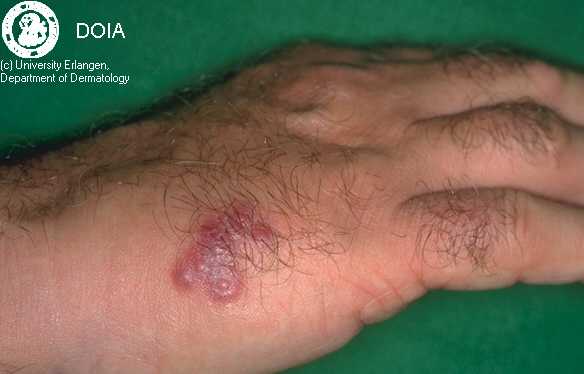
HSV on Hand |
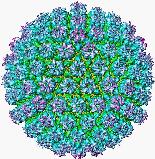
The herpes simplex virus
(HSV) is a double-stranded DNA virus with an enveloped, icosahedral capsid.
It is a common cause of infections of the skin and mucous membranes, manifesting
itself as tiny, clear, fluid-filled blisters usually around the mouth or
genitals. The virus infects more than 40 million Americans between
the ages of 15 and 75, and in extreme cases, can appear in and about
the eyes, esophagus, trachea, brain, and arms and legs (see below).
HSV has a great impact on human health globally due to its high prevalence,
successful sexual transmissibility rate, association with immunocompromised
patients, and ability to cause recurrent disease (Miller,
AHMF). There are two distinct types of the virus,
herpes simplex virus type-1 (HSV-1) and herpes simplex virus type-2 (HSV-2),
both of which are closely related a-herpesviruses
(having a broad host range). Although HSV-1 is mainly localized around
the oral region and HSV-2 around the genital region, it is quite possible
to transmit the virus to either region, from either region, resulting in
painful sores; the virus in incurable.

|

HSV on Hand |
Upon entering the body through oral or genital transmission, HSV penetrates the nerve cells (primary sensory neurons) in the lower layers of human skin tissue and replicates itself in the cell nuclei, thus destroying host cells. After destruction of the nerve cells, blisters and inflammation present itself in the region where the virus was contracted, oral or genital. Towards the end of the visible infection (3-14 days), viral particles are carried from the skin through the branches of nerve cells to ganglia, where the virus persists in a latent form until it recurs in an active, visible form (Miller, AHMF).
The recurrence rate of HSV-1(recurrent herpes) after the initial flare-up (primary herpes) is 20% to 40%, while the recurrence rate of HSV-2 is much higher at 80%. Men experience 20% more recurrences of genital herpes than women, even though symptoms in males are milder and shorter. Reactivation causes recurrent disease (oral or genital herpes), but most often it leads to shedding of infectious virus from the skin or mucous membranes, thus leading to further transmission of the virus. Transmission is usually accomplished when unrecognized or asymptomatic viral shedding is occurring. Active eruptions may occur as often as every few weeks or as seldom as once a year, and they usually appear at the same site. Many factors can initiate a recurrence, such as sunlight, menstruation, wind, fever, suppression of immune system, emotional stress, and intense dental work. Importantly, the immune system can never fully eliminate the virus; however, people with immunocompetent systems can have less severe and less frequent outbreaks (WebMD).
HSV-1
is considered to be oral-facial herpes (commonly appearing on the lips
and nares as cold sores), which is transmitted
mostly by oral lesions or secretions.
It is a very common disease affecting 1 out of every 1,000 persons.
The primary HSV-1 infection does not usually produce symptoms, but if so,
they can be very painful. Blisters form on the lips, and may also
form on the tongue. Painful open sores result from the blisters,
and a yellowish membrane develops prior to healing. The cycle lasts
between 3-14 days. In children, the infection is accompanied by increased
salivation and foul breath. Gingivostomatitis usually presents itself in
children as a primary infection (Miller,
AHMF), but recurs on the lower lip and rarely affects the
gums or throat.
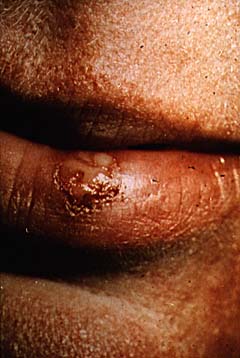 |
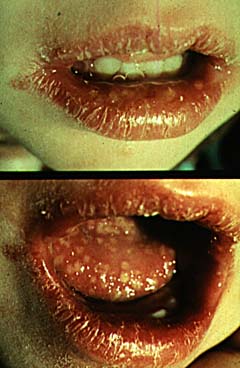 |
| HSV-2 is considered to be genital herpes, in which one in five people are correctly diagnosed. An estimated 45 million (one out of four) Americans are infected with the virus (JAMA). The virus is transmitted mostly by sexual contact, and it is possible to spread it when one is feeling perfectly well. HSV is highly contagious and either type can affect the mouth or genitals. Primary infection occurs around the genital area two to eight days after contracting the virus. Symptoms such as weakness and fever, headache, nerve pain, itching, lower abdominal pain, urinary difficulties, and yeast infections and vaginal discharge (in women) are characteristics accompanying the eruptions on the skin--only a minority of patients express these symptoms (WebMD). Atypical manifestations are frequently misdiagnosed or not recognized; however, lesions that are not entirely on the genitals, but below the waist around the anus, lower back or thighs, should be considered genital herpes by the clinician. | 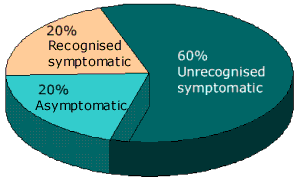 |
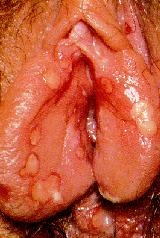 |
Women usually experience lesions around the vaginal opening, in the vagina, around the anus, or on the cervix. The lesions ulcerate then become filled with fluid, which is accompanied by swollen lymph glands in the groin, and the infection is usually active for six weeks and mostly painless. Women also seem to be at greater risk of contracting the disease, perhaps due to increased risk to a receptive partner. Another reason for greater risk is if the woman has not previously had an HSV-1 infection. It is believed that a prior infection would partially guard against infection with HSV-2 (Pielop et al., 2000). |
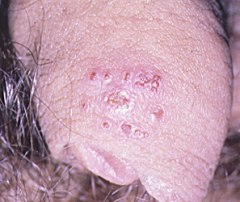 |
Men who contract herpes for the first time usually have no symptoms or a brief period of discomfort while urinating. More severe cases have small blisters that form open sores appearing on the tip or shaft of the penis. This can last for approximately two weeks, and a burning sensation during urination and clear discharge from the penis is common. Symptoms include lymph node enlargement, fever, tiredness, headache, and muscle aches during the episode. Recurrences are preceded by a tingling, itching or burning sensation on the penis one to two days prior to visible blisters and sores. Using condoms during sexual activity limits the spread of HSV infection (WebMD). |